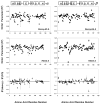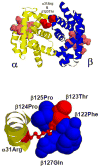A comparative NMR study of the polypeptide backbone dynamics of hemoglobin in the deoxy and carbonmonoxy forms
- PMID: 17497935
- PMCID: PMC2533159
- DOI: 10.1021/bi602654u
A comparative NMR study of the polypeptide backbone dynamics of hemoglobin in the deoxy and carbonmonoxy forms
Abstract
Model-free-based NMR dynamics studies have been undertaken for polypeptide backbone amide N-H bond vectors for both the deoxy and carbonmonoxy forms of chain-specific, isotopically (15N and 2H) labeled tetrameric hemoglobin (Hb) using 15N-relaxation parameters [longitudinal relaxation rate (R1), transverse relaxation rate (R2), and heteronuclear nuclear Overhauser effect (NOE)] measured at two temperatures (29 and 34 degrees C) and two magnetic field strengths (11.7 and 14.1 T). In both deoxy and carbonmonoxy forms of human normal adult hemoglobin (Hb A), the amide N-H bonds of most amino acid residues are rigid on the fast time scale (nanosecond to picosecond), except for the loop regions and certain helix-helix connections. Although rigid in deoxy-Hb A, beta146His has been found to be free from restriction of its backbone motions in the CO form, presumably due to the rupture of its hydrogen bond/salt bridge network. We now have direct dynamics evidence for this structural transition of Hb in solution. While remarkably flexible in the deoxy state, alpha31Arg and beta123Thr, neighbors in the intradimer (alpha1beta1) interface, exhibit stiffening upon CO binding. These findings imply a role for alpha31Arg and beta123Thr in the intradimer communication but contradict the results from X-ray crystallography. We have also found that there is considerable flexibility in the intradimer (alpha1beta1) interface (i.e., B, G, and H helices and the GH corner) and possible involvement of several amino acid residues (e.g., alpha31Arg, beta3Leu, beta41Phe, beta123Thr, and beta146His) in the allosteric pathway. Several amino acid residues at the intradimer interfaces, such as beta109Val, appear to be involved in possible conformational exchange processes. The dynamic picture derived from the present study provides new insights into the traditional description of the stereochemical mechanism for the cooperative oxygenation of Hb A based on X-ray crystallographic results.
Figures




Similar articles
-
Effector-induced structural fluctuation regulates the ligand affinity of an allosteric protein: binding of inositol hexaphosphate has distinct dynamic consequences for the T and R states of hemoglobin.Biochemistry. 2008 Apr 29;47(17):4907-15. doi: 10.1021/bi7023699. Epub 2008 Apr 1. Biochemistry. 2008. PMID: 18376851 Free PMC article.
-
NMR investigation of the dynamics of tryptophan side-chains in hemoglobins.J Mol Biol. 2002 Aug 30;321(5):863-78. doi: 10.1016/s0022-2836(02)00704-0. J Mol Biol. 2002. PMID: 12206767
-
Solution structure and dynamics of human hemoglobin in the carbonmonoxy form.Biochemistry. 2013 Aug 27;52(34):5809-20. doi: 10.1021/bi4005683. Epub 2013 Aug 15. Biochemistry. 2013. PMID: 23901897 Free PMC article.
-
Assessment of roles of surface histidyl residues in the molecular basis of the Bohr effect and of beta 143 histidine in the binding of 2,3-bisphosphoglycerate in human normal adult hemoglobin.Biochemistry. 1999 Oct 5;38(40):13423-32. doi: 10.1021/bi9911379. Biochemistry. 1999. PMID: 10529219
-
Protein dynamics explain the allosteric behaviors of hemoglobin.Biochim Biophys Acta. 2008 Sep;1784(9):1146-58. doi: 10.1016/j.bbapap.2008.04.025. Epub 2008 May 8. Biochim Biophys Acta. 2008. PMID: 18519045 Free PMC article. Review.
Cited by
-
Heme reactivity is uncoupled from quaternary structure in gel-encapsulated hemoglobin: a resonance Raman spectroscopic study.J Am Chem Soc. 2012 Feb 22;134(7):3461-71. doi: 10.1021/ja210126j. Epub 2012 Feb 9. J Am Chem Soc. 2012. PMID: 22263778 Free PMC article.
-
New look at hemoglobin allostery.Chem Rev. 2015 Feb 25;115(4):1702-24. doi: 10.1021/cr500495x. Epub 2015 Jan 21. Chem Rev. 2015. PMID: 25607981 Free PMC article. Review. No abstract available.
-
Insights into the solution structure of human deoxyhemoglobin in the absence and presence of an allosteric effector.Biochemistry. 2007 Sep 4;46(35):9973-80. doi: 10.1021/bi700935z. Epub 2007 Aug 11. Biochemistry. 2007. PMID: 17691822 Free PMC article.
-
Conformational Dynamics of Phytoglobin BvPgb1.2 from Beta vulgaris ssp. vulgaris.Int J Mol Sci. 2023 Feb 16;24(4):3973. doi: 10.3390/ijms24043973. Int J Mol Sci. 2023. PMID: 36835381 Free PMC article.
-
Solution NMR Spectroscopy for the Study of Enzyme Allostery.Chem Rev. 2016 Jun 8;116(11):6323-69. doi: 10.1021/acs.chemrev.5b00541. Epub 2016 Jan 6. Chem Rev. 2016. PMID: 26734986 Free PMC article. Review.
References
-
- Dickerson RE, Geis I. Hemoglobin: structure, function, evolution, and pathology. Benjamin-Cummings; Menlo Park, CA: 1983.
-
- Perutz MF. Stereochemistry of cooperative effects in haemoglobin. Nature. 1970;228:726–739. - PubMed
-
- Silva MM, Rogers PH, Arnone A. A third quaternary structure of human hemoglobin A at 1.7 A resolution. J Bio Chem. 1992;267:17248–56. - PubMed
-
- Safo MK, Abraham DJ. The enigma of the liganded hemoglobin end state: a novel quaternary structure of human carbonmonoxy hemoglobin. Biochemistry. 2005;44:8347–59. - PubMed
-
- Kavanaugh JS, Rogers PH, Arnone A. Crystallographic evidence for a new ensemble of ligand-induced allosteric transitions in hemoglobin: the T-to-Thigh quaternary transitions. Biochemistry. 2005;44:6101–6121. - PubMed
Publication types
MeSH terms
Substances
Grants and funding
LinkOut - more resources
Full Text Sources

